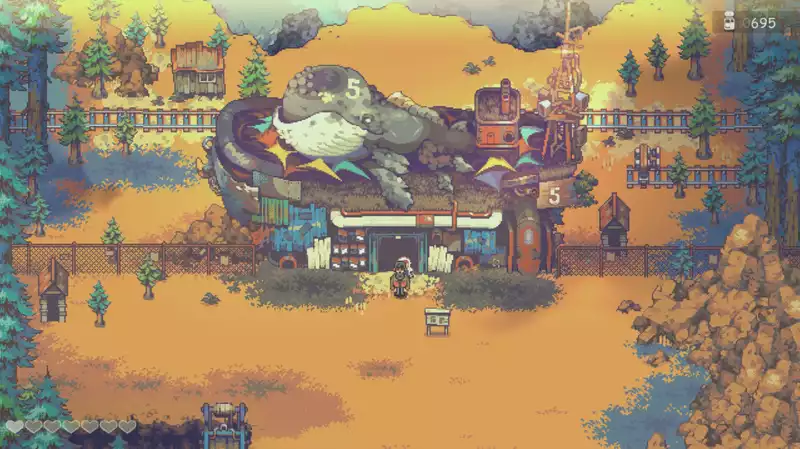Set in a world where humanity clings to fragments of civilization, "Eastward" draws inspiration from old RPGs, "Earthbound," "Zelda," and Studio Ghibli films to create beautiful, desolate locations with a mix of puzzle and action. The game is a dot-picture old-school RPG. Despite looking like an old-school RPG with dots, each environment is packed with detail and truly gorgeous, just like a Ghibli film. The game pays homage to the famous Japanese animation studio, and Hayao Miyazaki himself is hidden in the starting town of Pot Clock Isle.
"Eastward" portrays John, a mute miner who uses a frying pan for both cooking and fisticuffs, and Sam, a white-haired girl. The two develop a father-daughter relationship while earning a living in the underground town of Pot Clock Isle, but when they are banished to the wastelands of the aboveground world, they realize that things are not what they seem. After leaving the first area, the story begins in earnest, around the time when a deeper mystery appears.
The puzzles are very Zelda-like, with weights placed on platforms to keep doors from opening, bombs thrown into gaps, and characters split up to make way for each other. Some sections felt a bit repetitive, especially where I had to speed up to solve a puzzle to avoid being consumed by the spreading miasma, and I had to step away for a bit to cool down. Not that the puzzles themselves were difficult, but there wasn't enough time to figure them out and complete them before dying. Repetition and frustration ruined the tension, but such things are thankfully few and far between in the eastward progression.
Monsters, such as waddling mushrooms and bomb-spitting duck plants, are quite cute and can usually be defeated with a few pan attacks. To defeat the bosses, you first need some sort of gimmick to lure them out of hiding or get them to stand still. John's trusty frying pan is comfortable to smash, but it is difficult to aim, and switching between frying pan and gun slows him down, so many times I was caught off guard. However, switching between John and Sam and using energy blasts is incredibly quick and helps keep you fresh.
Where Eastward really excels is in its atmosphere. It somehow straddles the line between the retro feel of the pixels and the modern feel of the details and lighting. New Dam City is a highlight, with its densely packed Japanese-style houses and alleys, yet filled with potted plants and power lines. The rest of the area is unsettling, and a sense of unease creeps in as you move deeper into the area. One minute you're exploring a lovely forest, the next, robotic eyes are following your every move. It replicates the sensation of passing over railroad tracks or the sensation of a heartbeat in tense situations.
The music, too, lingers in your mind long after you stop playing, a chiptune love letter to 90's gaming that will definitely be on many a "lo-fi chill beat to study to" playlist. The text design is also excellent, with speech bubbles shaking with surprise and speech balloons moving slowly during tense moments. It's a master class in how to give a character personality without voice acting.
Eastward is full of unique characters, and even the NPCs who just go about their day shine. The downside is that when everyone in the room is weird and wacky, no one really stands out. It feels like you're constantly hitting a wall of chatter and it's hard to discern what's important. In addition, the fact that you get to know a particular character so well, only to never see that person again, means that it becomes difficult to feel attached to anyone.
Relatively early on, John attracts a fan base called Uva, the romance element is abrupt and simplistic, there are grandmothers who meddle with it, and each must have their own "moment" as part of the comedy. These women are unnecessary and overbearing. It's a shame that they have to compete with each other, because the individual cast members are all great. John's stoic solidity stands out because he is the only one who doesn't speak.
Along with the main game, there is a terminal that allows you to play an old-school 8-bit RPG called "Earthborn," which offers classic turn-based combat like the early "Dragon Quest" games. It's surprisingly deep, and hearing the various characters on the journey get into this RPG makes the world Sam and John are exploring feel all the more real. Cooking and finding new recipes to create healing items is a fun distraction, and features nice, bouncy animations that are just as fun as those in Breath of the Wild.
As an homage to the RPGs of the 90s, "Eastward" is wonderful and has an atmosphere to savor. However, while the central mystery is fascinating, it fails to tie the various threads together into one, leaving several plot holes in the end. It also struggles to maintain momentum, and at times the characters feel over-written. While I enjoyed basking in the sun-drenched forests and cowering in abandoned subway stations, I also found myself wanting to get on with certain parts of the book and get it over with. While "To the East" never quite reaches the same heights as the work that inspired it, it does make a commendable effort.
.

Comments